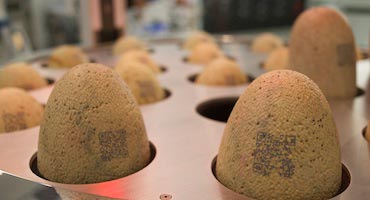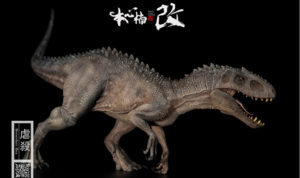The Prehistoric Animals of Jurassic World – Indominus rex
The Making of Indominus rex – “Fierce or Untameable King”
The back story to the forthcoming film “Jurassic World” goes something like this. With the death of Dr John Hammond the founder of InGen in 1997, (according to the film franchise timeline), the corporate giant Masrani began negotiations to acquire the company and within twelve months InGen was part of the Masrani conglomerate. A plan to develop and reopen the “Jurassic Park” attraction was put forward shortly afterwards and in around 2000, the go ahead was given to create a dinosaur led attraction on the island of Isla Nublar.
“Jurassic World”
The attraction, known as “Jurassic World” was built between the years 2002 and 2004, construction materials alone are estimated to have been around $1.2 billion USD. To give readers an appreciation of the costs of developing the new attraction, the construction of the new Wembley stadium (London), completed in 2007, cost around $2 billion USD in total. The development of “Jurassic World” was a huge and ambitious undertaking for Masrani, the decision to go ahead with the project coincided with Masrani Global Corporation’s NASDAQ market debut (2000), the theme park was seen as a “flagship” enterprise for the organisation. With many new shareholders to impress, the park had to be a success and when it opened in June 2005, it proved to be a huge hit, attracting 98,120 visitors in the first month alone.
Masrani – Ten Years of Making Dinosaurs
Picture credit: Masrani
The Need to Build Bigger and Better Attractions
Anyone who has ever played the video game “Theme Park”, (which was originally released in 1994, just a year after the original Jurassic Park movie hit cinema screens), knows that the rides and the park itself needs to be constantly refreshed and updated to keep visitor numbers up. With visitor numbers at “Jurassic World” beginning to fall or at best plateau, in the last two to three years, investors began to grow concerned. Revenue from ticket sales, merchandise and other income streams were not growing as strongly as they once were, this prompted Masrani’s Chief Operations Officer, Richard Wiesner, to describe the 2013 results for “Jurassic World” as merely acceptable, despite profits from the theme park exceeding 20 million USD that financial year.
Acceptable Profits
Richard Wiesner stated:
“The world has seen what we have to offer, but they aren’t in awe as they once used to be. We need to change that. You can’t expect the world’s greatest theme park to merely rely on the same attractions. We need to be proactive, thinking of bigger and better things.”
Putting things in perspective, EuroDisney (Paris) over the same period posted a loss of 78 million Euros, but apparently Masrani wanted bigger and better…
Dr Henry Wu’s Contribution
The chief scientist at InGen, Dr Henry Wu, one of the world’s leading geneticists, had successfully combined the DNA of a number of plant species to create the “Wu flower” (Karacosis wutansis) back in 1997. As one of the architects of the prehistoric animals in the failed “Jurassic Park” experiment, Wu was installed as one of the lead scientists to genetically engineer a whole new generation of dinosaurs for the new attraction “Jurassic World”. InGen remained a separate company within the Masrani portfolio and one can only speculate on where their genetic research took them, but in response to the call to create bigger and more exciting attractions, it was Dr Wu and his team who were given the task of developing a hybridised dinosaur.
The project to create a genetically engineered, hybridised dinosaur is believed to have started in late 2012. This was to be an entirely new species, one that had genetic traits from a variety of theropod dinosaurs combined with other extant (living species) – the Indominus rex project was begun.
Indominus rex
The Group’s Chief Executive Officer Simon Masrani announced in 2014, that the company had been able to successfully engineer a new type of dinosaur. Once the news story broke, on line ticket sales to the park “skyrocketed”, it looks like 2015 is going to be a very big year for “Jurassic World”. The dinosaur has been named Indominus rex (fierce or untameable king), note, we at Everything Dinosaur prefer to spell untameable with an extra “e”. The new dinosaur attraction is due to open this summer and we all know that this is going to end very badly.
As Owen Grady (played by Chris Pratt) states:
“You just went and made a new dinosaur, probably not a good idea”
New Dinosaur on the Block – Indominus rex
Nanmu Studio have introduced a range of prehistoric animal figures paying tribute to dinosaurs seen in cinema releases: Nanmu Studio Models.
If Dr Wu’s brief had been to create a bigger, more dangerous, fiercer and more intelligent dinosaur, then the project does seem to have achieved its goal. We at Everything Dinosaur don’t know quite how the genome for this new theme park attraction was put together, originally there were two creatures, but one was eaten by the other. I. rex does indeed look to be a mix of different meat-eating dinosaurs, with osteoderms resembling those seen on abelisaurids (Carnotaurus, Majungasaurus and Rugops are mentioned) and the Late Jurassic Ceratosaurus, three-fingered hands of an allosaurid, but with much larger and more highly recurved claws, there is probably a bit of T. rex and a pinch of dromaeosaurid in there too.
Indominus rex – Dinosaur Attraction Due to Open in Summer 2015
Picture credit: Universal Studios
A New Hybrid Dinosaur
In the pre-launch publicity for the attraction, it is stated that this new hybrid can run up to speeds of 30mph (48kmh), within the confines of its enclosure and that I. rex can roar as loudly as 140-160db, the sound created when a Boeing 747 jet takes off. At around twelve metres, that is a phenomenal growth rate, much faster than the estimated growth rate for any other large theropod. Amongst all that dinosaur DNA, to obtain such a rapid growth rate, we speculate that some song-bird genes much have been thrown into the mixer, after all, blackbirds for example, can reach almost adult size in just a few weeks. Although the growth rate of various members of the Theropoda are not that well understood, ontogenic studies have suggested it was actually prey such as ornithopods that grew much more quickly.
To read about a study into dinosaur growth rates: Duck-billed Dinosaurs Grew Up Fast to Avoid Tyrannosaurs.
Awaiting the Film Release
Just how big this dinosaur could grow can only be speculated. We suspect that in the forthcoming film this dinosaur will meet its demise, how this happens is one of the most closely guarded secrets in the history of the film franchise. Could Indominus rex fight Tyrannosaurus rex? Would a Spinosaurus (the big villain in Jurassic Park III), become involved somehow? Like millions of dinosaur fans around the world we shall have to wait until the second week of June to find out.



